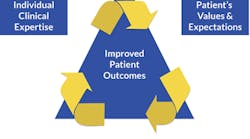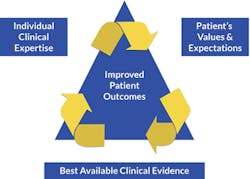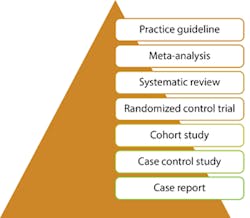A review of the evidence includes the two-bottle mouth rinse
By Kandra Sellers, RDH, BA, and Patti DiGangi, RDH, BS
With research linking gingival inflammation to many systemic conditions, it's now more critical than ever to provide patients the information to make informed decisions. Many professionals struggle when recommending a rinse to decrease inflammation as a way to improve patients' oral health without a lot of unwanted side effects. Patients give us the gift of caring for their health; they deserve the very best care we can offer in step with their values and expectations.
In 1910, the Mayo brothers of the famous Mayo Clinic said, "A healthy mouth can help you live 10 years longer." The mouth is truly the gateway to good health. When there are signs of inflammation with gingivitis, periodontal disease, or with restorative or surgical procedures – to name a few – the faster the inflammation is addressed, the better for overall health. As dental health-care professionals, we have the opportunity to save lives.
Learn by Example
Oral rinses are one way to reduce inflammation, and a myriad of choices are available to consumers. Each rinse has its own distinct properties as well as marketing that can be good, bad, or sometimes misleading to the consumer and professionals. Our expedience as dental coaches is that the product of choice doesn't matter as much as using it routinely in your practice as a key to individual patient recommendations. Having patients prerinse with the product you choose is important in decreasing the bacterial aerosols to anyone entering the clinical area. More importantly, prerinsing decreases the potential for bacteria that could enter the patient's bloodstream during dental procedures.
--------------------------------------------------------------------------
Consider reading these articles
- Revisiting preprocedural mouth rinses as an infection prevention tool
- Choosing and using preprocedural rinses
- Closing a gap in oral health-care management
--------------------------------------------------------------------------
Using a prerinse with the product of your choice reduces patients' confusion about your message. Clear communication is not just the words we use. The message becomes crystal clear when the patient experiences the best product available for them chairside. In the patient's eyes, if it is good enough to use chairside, it is probably the best thing for them to use at home too.
Many times offices will have one product sitting on the counter and then try to enroll the patient in using something completely different at home. This creates a mixed message and decreases the trust in your recommendations, decreasing your opportunity for enrollment and compliance by the patient.
Overwhelming Choices
Do you routinely go down the retail aisles in your local stores? It can be an overwhelming experience. Shelves are loaded with many products with claims that may or may not be true. Is there science to back the claims?
The first and foremost purpose of evidence-based dentistry (EBD) is improved patient outcomes. The way this can be reached is the overlap between (see Figure 1):
- Best evidence
- Clinical expertise
- Patient values and expectations.
As professionals, it is our role and duty to know the difference between marketing claims and science. There is nothing inherently wrong with marketing; what the patient desires is part of the EBD equation.
Most everyone wants white teeth. A product can be developed that says it whitens. Whether or not it does, the science behind the claim depends on how the product is approved or not. Some products are considered cosmetic, and, as such, do not have the science to back the claim. The patient does not get the end result they paid for and can feel frustrated and ultimately confused by all the propaganda.
Patients do not necessarily know what the right product is for them. They often choose based on the marketing and shelf location. Products with higher sales get a more prominent place. Does that make it a product better? We know that is not the case. The product may not necessarily be what is best for the individual; in fact, many products can harm the patient or cause adverse side effects.
One overlapping part of EBD is our clinical expertise. It is our role as the dental professional to educate and recommend what is best based on the patient's individual oral needs as well as their systemic health. There are many benefits to providing the product from the office as shown in Table 1.
Available Options
Chlorhexidine (CHX) ruptures the bacterial cell membrane, leading to rapid leakage of cell contents and cell death. CHX is often referred to as the gold standard to which other rinses are compared. Yet it's not without side effects (stain, alteration of taste, increased calculus formation, poor compliance, permanent stain to resin restorations, and not recommended for long-term use) and requires a prescription. CHX is approved by the FDA only for use with gingivitis, not periodontitis, and is, in fact, not effective in the presence of blood.1-2
Cetylpyridinium chloride (CPC) is similar to chlorhexidine in that it too ruptures the bacterial cell membrane, leading to rapid leakage of cell contents and cell death. Many cosmetic mouth rinses contain CPC at concentrations below 0.045%, and do not provide antiplaque or antigingivitis benefits.
Essential oils have been around for a long time. Essential oils exhibit a broad spectrum of activity against gram-positive and negative bacteria, as well as fungi. Essential oil rinses are available in both alcohol-containing and alcohol-free versions; however, the alcohol-free products might not meet the same efficacy standards.
Delmopinol hydrochloride 0.2% is a proprietary key ingredient that creates a less-adhesive environment for bacteria and biofilm and is new to the U.S. market.
Chlorine dioxide has been around for almost 200 years. The advantage of using rinses with chlorine dioxide include: they do not contain alcohol; they do not cause staining; taste is not altered; use can be long term; and it can be used with or without flavorings. Conveniently, they do not require a prescription.
New technology with the ability to remove volatile sulfur compounds (VSCs) from cultures of periodontal pathogens is now available. Research has shown bad breath is caused by anaerobic bacteria that live on the back of the tongue and from periodontal disease. These pathogens feed on the leftover proteins producing VSCs as a byproduct. These include:
- Hydrogen sulfide
- Methyl mercaptan
- Cadaverine
- Skatole
Hydrogen sulfide is poisonous, corrosive, flammable, and explosive. Studies show methyl mercaptan is not only one of the sources of oral malodor, but may also play a role in the pathogenicity of P. gingivalis. Think about the word cadaverine for a moment. Now, are you seeing a different picture? Mouth odor is much more than something socially unacceptable.
For some patients, no matter what they do, halitosis continues due to the VSC levels. This problem with halitosis has brought a rise in popularity of rinses containing chlorine dioxide, which neutralizes volatile sulfur compounds. Studies show that there is a significant improvement in malodor intensity, and chlorine dioxide reduces VSC concentrations in the mouth air for at least eight hours after use.3 This has been an amazing revelation, creating thousands of satisfied patients, giving them confidence to open their mouths and be able to have conversations with others without worrying about the foul odor. This reduction in VSCs also may support their systemic health.
A Deeper Look at Chlorine Dioxide
The properties of chlorine dioxide deserve a deeper, more in-depth understanding for clinical application. There are two types of chlorine dioxide: stabilized chlorine dioxide (sodium chlorite) and chlorine dioxide as a gas. Stabilized chlorine dioxide is in a salt form in solution with bicarbonate, and is very safe.
Stabilized chlorine dioxide is registered with the Environmental Protection Agency (EPA) as an excellent bactericide, fungicide, and antimicrobial agent. It has been approved for use in food processing plants to sanitize and control bacteria and mold. It is also used by U.S. soldiers in the field for purification of their water. It is used in critical-care areas in hospitals. It is used for removal of mold and fungal contamination in flooded and fire damaged areas. Chlorine dioxide has been successfully used for several decades in many countries.4
It is important to know that stabilized chlorine dioxide in the above-mentioned uses is not in the same form as that which is contained in oral health-care products such as toothpastes and mouth rinses. The dental industry's forms of stabilized chlorine dioxide come with activating agents that convert sodium chlorite to active chlorine dioxide. This is why it is so effective in killing microbes. This activation within stabilized chlorine dioxide does not occur in most oral hygiene products. In most oral health products, little to no conversion takes place, and the sodium chlorite remains in the inactive form with much lower VSC inactivation and lower microbial killing power.
To make stabilized chlorine dioxide for oral use, sodium chlorite is manufactured into a liquid with a more basic pH. Various sodium carbonate complexes are added to the formulation. Those complexes are then able to link and bond onto the sodium chlorite to stabilize it, not chlorine dioxide. These oral health products stating they have "stabilized chlorine dioxide" can be confusing to people, and it would be more accurate to state that they are products with "stabilized sodium chlorite" in them.
A few products contain true chlorine dioxide. Packaging is the biggest trick to transporting them and making them effective. Some products in the past were sold containing chlorine dioxide already mixed in a single bottle. Two weeks after being opened, the chlorine dioxide had gassed out of the liquid, and no longer had bactericidal benefits to the patient. The way to overcome this issue is to have a product that makes true chlorine dioxide gas in liquid at the time of use. This method requires activation at the time of use, such as a two-bottle system, mixed equally with each use.
Science brings us a new option with OraCare, which was recently introduced to the dental market by Dentist Select (www.dentistselect.net). OraCare is a two-part system. One bottle is sodium chlorite, and the second bottle is lactic acid, other mild acids, buffers, and catalysts. Equal amounts of liquid from each bottle are mixed and sit for 30 seconds, activating the chlorine dioxide so it is ready to fight pathogenic bacteria, fungus, and viruses.
Enough Science?
The world of EBD continues to evolve. For a long time, random control trials were at the top of the EBD pyramid. As shown in Figure 2, this is no longer the case. Systematic reviews, meta-analysis, and practice guidelines come higher on the pyramid. Products that have been on the market for a long time often have a larger body of research, and it may be easier to perform a meta-analysis and systematic review. Does this mean the product is necessarily more efficacious than a newer product? The answer is no.
Everything was new at one time. Before the Framingham Heart Study5 started right after World War II, increasing blood pressure was thought to be normal and desirable with aging. This sounds ridiculous based on current science. For many years in dentistry, implants were thought to be risky and experimental. Many insurance carriers would not cover them. This too sounds ridiculous at this point in time. The emerging science for lowering blood pressure and placing implants was not accepted by those invested in the old ways. The body of science wasn't as large.
This is true today with new products and procedures in dentistry. The question becomes: When is there enough science? We all dream of a single product answering the questions for all patients, but this is an unrealistic expectation. There is no one-size-fits-all diagnosis, treatment, or product. Every individual has individual needs, wants, desires, and health issues. OraCare is another arrow in our quiver of options for patients. Going back to the EBD equation, products need to match with patients' values, expectations, needs, and desires.
When the patient is properly coached about the benefits, they will invest their time and effort into what is recommended. This is particularly true when the coaching shows the individual a direct correlation of their oral and systemic health.
Personal limiting beliefs of practitioners are readily detected by patients and ultimately lead to a decrease in use, if they bother at all. This is true for any aspect of patient enrollment, whether it's a product, restorative treatment, or hygiene service. The dental professional must believe in the coaching provided and come across with confident presentation and communication skills. Beliefs get results.
If your success rate in enrollment in products or treatment is poor, reach out for coaching to enhance your communication skills. It is not something we were taught in dental hygiene school, just as dentists where not taught how to manage a business. Coaching is a great addition to your professional development and personal growth. Cherish the dentist's investment in your excellence and everyone wins. We are taking the very best care of our patients as they deserve for trusting us with their lives.
Table 1: Reasons to dispense products from your office |
Reducing the confusion at the store |
Save the patient time trying to find recommended products |
| Increase practice profits by taking the very best care of your patients |
Going beyond the standard of care |
| Creates value in their appointment, the practice, and you as their provider |
Increase patient compliance due to ease of access. |
Dental author's recommendation of chlorine dioxide
Over 2 million implants are placed annually, which has changed the dynamics of clinical dental hygiene in terms of the risk for infection of the periodontium and challenges what we face as clinicians with overall systemic health. Susan Wingrove, author of a new book and an amazing resource for the entire dental team called "Peri-Implant Therapy for the Dental Hygienist: Clinical Guide to Maintenance and Disease Complications," states that chlorine dioxide is the recommended rinse postsurgically and for long-term daily maintenance of implants due to the antibacterial, antiviral, and antifungal benefits.
Wingrove's recommendation is also based on the research showing that chlorine dioxide does not interfere with osteoblasts and fibroblastic activity, which can initiate healing. As a hygienist, she feels strongly that it is critical for dental professionals to be confident and be able to discuss implant treatment options, meeting the challenges of providing safe and effective implant maintenance to promote the best long-term treatment choice for tooth replacement.
Wingrove is an international speaker who does regeneration research and instrument design. She has published many articles on advanced hygiene, regeneration, and implant dentistry in national and international journals. Her book includes comprehensive systems for assessment, instrumentation, monitoring, and peri-implant disease treatment based on the current textbooks. This is a must-have for every hygiene department in order to have proper protocols and understanding, in conjunction with exceptional maintenance of our implant patients.
Kandra Sellers, RDH, BA, is currently an executive coach for Hygiene Mastery and a regional owner/executive coach for Fortune Practice Management in Illinois and Michigan. She holds certification in laser therapy and advanced practice techniques. She can be contacted at [email protected].
Patti DiGangi, RDH, BS, holds a publishing license with the American Dental Association for Current Dental Terminology and is an ADA Evidence-Based Champion. She is a National Speaker's Association Certified Speaking Professional candidate. Patti received the Sonicare/RDH magazine Mentor of Distinction award at the 2013 ADHA annual session. Her website can be viewed at www.pdigangi.com.
References
1. Wade W, Addy M. In vitro activity of a chlorhexidine-containing mouthwash against subgingival bacteria. J Periodontol. 1989;60: 521–525. Available at: http://www.mendeley.com/research/in-vitro-activity-of-a-chlorhexidinecontaining-mouthwash-against-subgingival-bacteria/
2. Mankodi S et al. A 6-month clinical trial to study the effects of a cetylpyridinium chloride mouth rinse on gingivitis and plaque. Am J Dent. 2005;18:9A-14A. Available at: http://www.amjdent.com/Archive/2005/July%2005%20SI%20-%20Press.pdf
3. Frascella J, Gilbert RD, Fernandez P, Hendler J. Efficacy of a chlorine dioxide-containing mouth rinse in oral malodor. (2000) Compend Contin Educ Dent. 2000 Mar;21(3):241-4, 246, 248. Last accessed 7/31/13.
4. Chlorine dioxide: The most flexible and effective biocide available. (2013) Scotmas Group. Last accessed 7/31/13. http://www.scotmas.com/what-we-do/chlorine-dioxide.aspx
5. Framingham Heart Study. (2013) National Heart Lung Blood Institute. Boston University. Last accessed 8/1/13 http://www.framinghamheartstudy.org/







